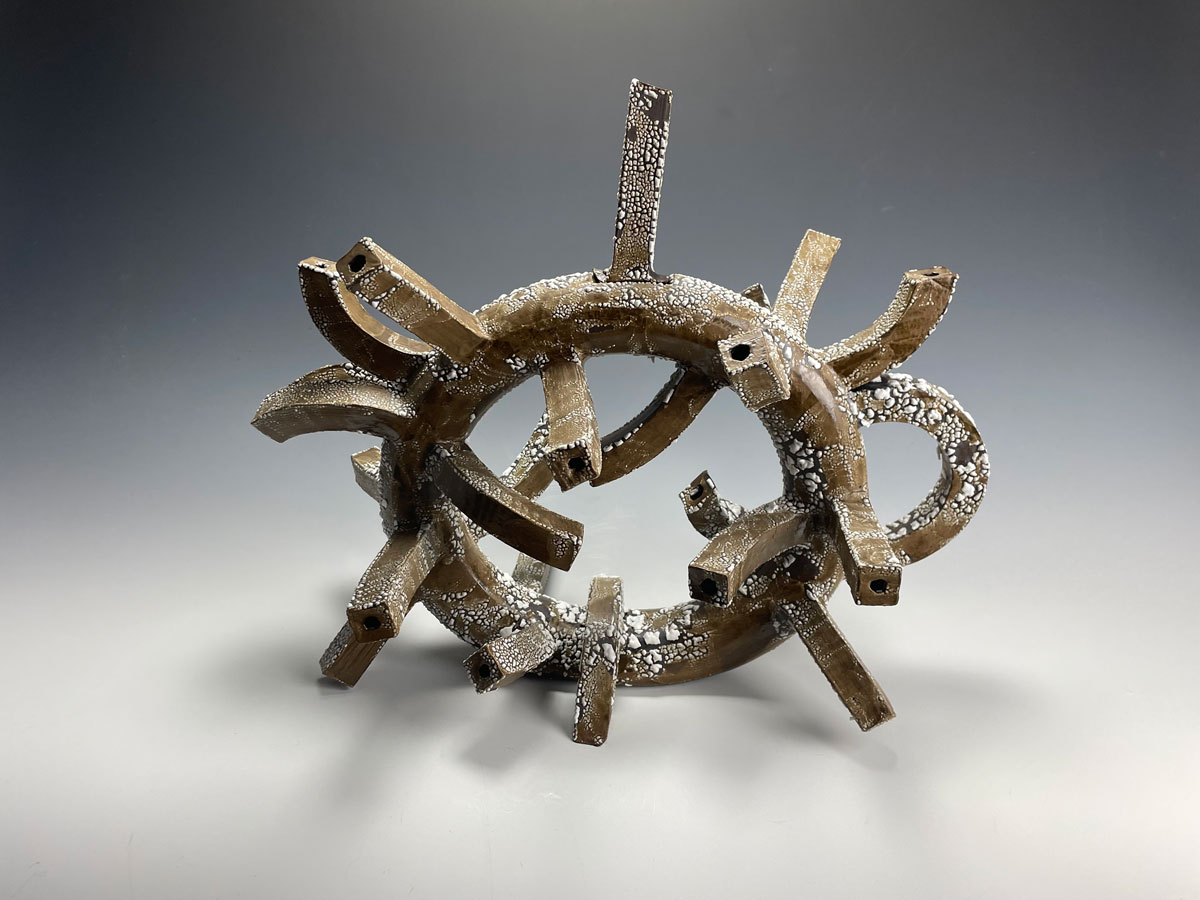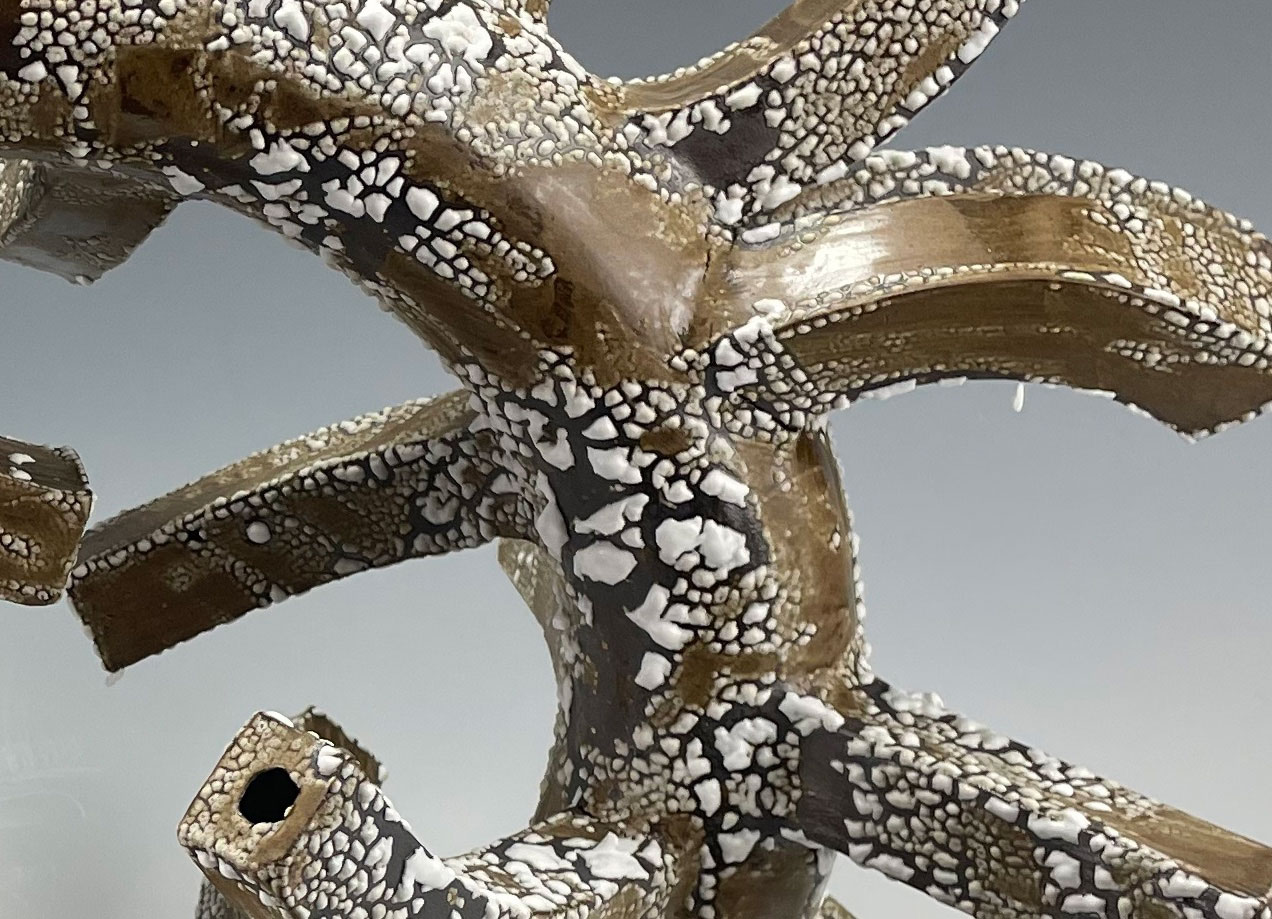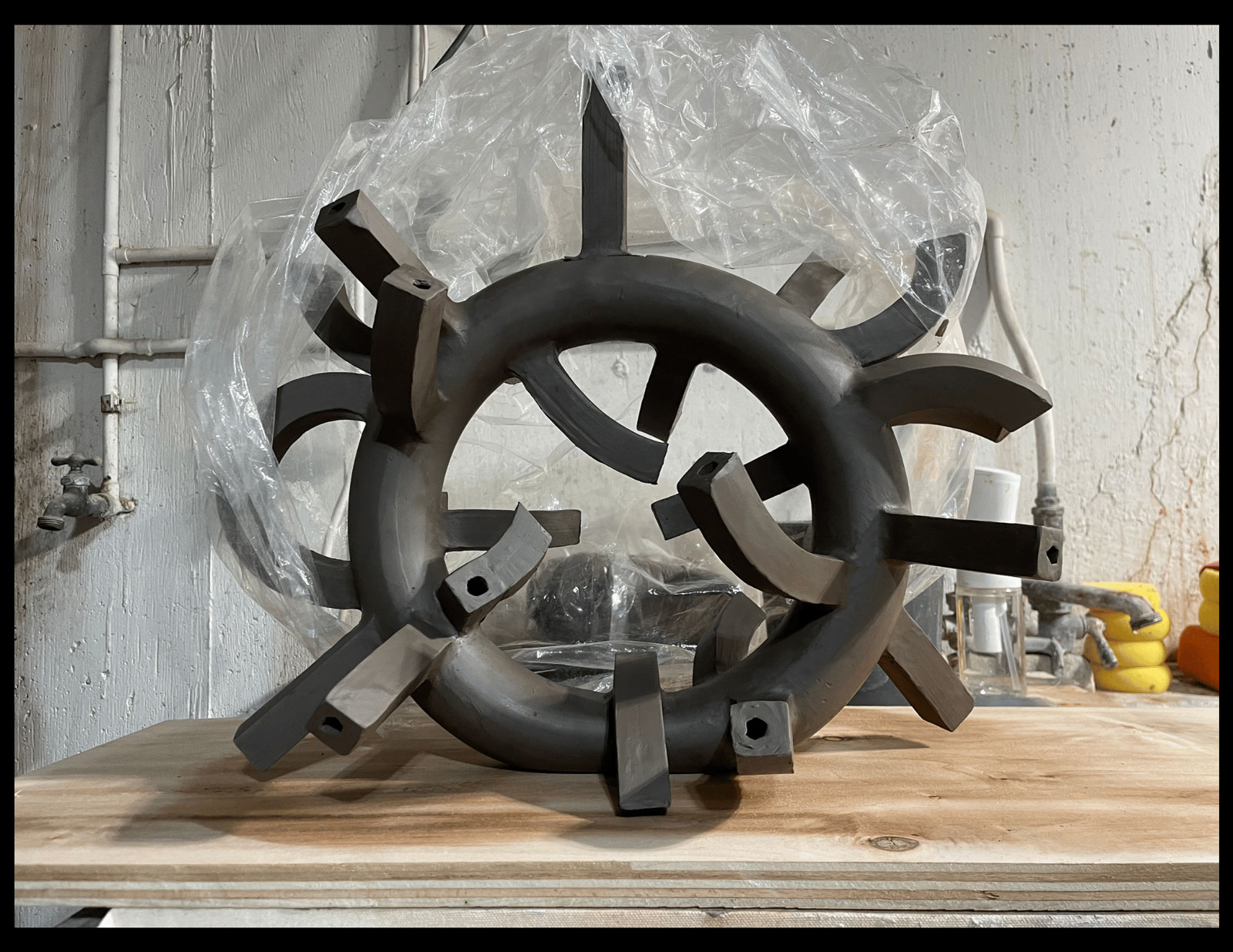

Trick? Or Treat?

Height: 14" x Width: 16.5" x Depth: 8.5" | Material(s): White crawling glaze provides surface texture and accentuates dark ^6 clay, making pot unappealing. | Process(es): Attached extruded rectangular prisms to surface of wheel-thrown donut pot. Thick layer of glaze. | Citation(s): Inspired by Japanese trick pots | Idea(s): Inspired by Japanese trick pots, only one spout is functional; handles are intentionally misleading. | Curatorial Note: Dynamic use of wheel-thrown parts in combination with extruded parts as a solution for a teapot. Great use of surface decoration.
Lorenzo Gray-Liva


Student statement
Student statement
Does your work reference or draw on a contemporary or historical art-making style, practice, or tradition? If so, please explain.
My teapot was inspired by the concept of an “assassin’s teapot,” originating in Asia. Assassin’s teapots would have two or more separate compartments, utilizing physics and a set of openings to determine which compartment would release liquid. The pourer would lower their victim's inhibitions by pouring themselves a cup of normal tea to prove it is untarnished, then altering their finger placement and pouring a cup of poisoned tea. These teapots were intentionally tricky, with complicated surface adornments to mask the holes, making it difficult for anyone but the trickster to operate.
How did this artwork relate to your sustained investigation inquiry?
I have consistently struggled with creating ceramic works with adornments. Attachments as simple as handles or spouts would always crack or fall off, or not be up to my standards. Thus, I wanted to create a portfolio that allowed me to grow in this aspect, further demonstrating my strengths and weaknesses. However, simply creating pots with parts attached seemed a bit basic, so I included an aspect of surface adornment as well. This idea of juxtaposing the glaze application and the concept of the structure of the pot was fascinating and allowed me to experiment with different glazes, glaze applications, firing schedules, and other techniques that I would have otherwise never experienced.

After tinkering with glaze chemistry and exploring different surface adornments and applications for different types of kiln firings, I further investigated the correlation by gathering inspiration from my surroundings.
How did you practice or improve your written inquiry statement as your portfolio developed?
For each piece I desired to create, I had to first describe every aspect of the project from descriptions as simple as what clay body would be used to depictions of what feelings the final piece would evoke. This allowed for a primary establishment of ideas, materials, and processes. After completing the work, I wrote a descriptive reflection about what went well, what did not, and how I would improve and mitigate potential disruptions in future works. Writing an in-depth comparison of my artwork before and after completion was essential in writing the statements accompanying each piece of my portfolio and allowed me to communicate the ways I learned and grew as an artist throughout the making of an artwork.
How did your art teacher support your artistic development?
My high school has an incredible art department, yet before my senior year, they lacked an AP Art curriculum, a class that I knew I wanted to pursue. I spoke with the art department chair and they started working behind the scenes to create an AP Art curriculum to allow my entire focus to be on creating a portfolio. My art teacher and the entire art department were integral in my artistic development, consistently giving feedback throughout the process of creating a work. Not only did my art teacher support me emotionally when ceramics didn’t go my way, but she was also very lenient with deadlines, which may seem like an unfavorable way to encourage creating art, but it worked well with my academic schedule and reduced unneeded stress.

Material(s): White crawling glaze provides surface texture and accentuates dark ^6 clay, making pot unappealing. | Process(es): Attached extruded rectangular prisms to surface of wheel-thrown donut pot. Thick layer of glaze. | Citation(s): Inspired by Japanese trick pots.
How did your school leadership (principal, assistant principal, guidance counselor, etc.) support your growth as an art student? This could be classroom visits, attending art shows, talking to you about your goals, etc.
Although I wanted to continue to grow as an artist by taking an art class, I wanted to ensure I continued my academic rigor through my senior year and was thus split between taking an AP science class that more aligned with my major versus an AP art course. My college counselor aided me tremendously in weighing this decision and ultimately suggested I follow my interests. At the end of the year, I presented my work to the administration, the art department teachers, my college counselor, and my advisor and was given a lot of feedback for my future artistic endeavors.
What is your advice to other AP Art and Design students?
If you truly have a passion for art, pursue it in some form or another. However, don’t feel as if you have to go to art school to create an AP portfolio. It can always be a passion that you pursue along with your career. If you want to go to art school, however, all the power to you. Simply try your hardest to continue to do the things that bring you happiness, and often that is the creation of art.

Material(s): Dark ^6 clay body. PVC pipe and clay bags create a jig to hold up structurally unsound pot. | Process(es): Thrown spouts and handles weren't same moisture level as donut vessel; most broke off, had to redo. | Idea(s): Only one spout is functional; handles are intentionally misleading.
déclaration de l'étudiant
déclaration de l'étudiant
FRANÇAIS
Quel est le lien entre ce projet artistique et votre question de recherche approfondie ?
J'ai toujours eu du mal à créer des œuvres en céramique avec des ornements. Des accessoires aussi simples que des poignées ou des becs verseurs se fendaient ou tombaient, ou n'étaient pas à la hauteur de mes exigences. J'ai donc voulu créer un portfolio qui me permettrait de m'améliorer en montrant davantage mes points forts et mes faiblesses. Cependant, créer des pots avec des pièces attachées me semblait un peu simpliste; j'ai donc également inclus un aspect de fioriture de la surface. Cette juxtaposition de l'application de la glaçure et de la structure du pot était fascinante et m'a permis d'expérimenter avec différents émaux applications d’émail, programmes de cuisson et autres techniques que je n'aurais autrement jamais utilisées.
Comment avez-vous pratiqué ou amélioré la rédaction de la définition de votre recherche lors de la création de votre portfolio ?
Pour chaque pièce que je souhaitais créer, je devais d’abord décrire chaque aspect du projet, depuis des descriptions aussi simples que le type d’argile qui serait utilisé jusqu’aux descriptions des sentiments que la pièce finale évoquerait. Cela m’a permis d’établir un premier ensemble d’idées, de matériaux et de processus. Après avoir terminé chaque pièce, j’ai écrit une réflexion descriptive sur ce qui s’était bien passé, ce qui n’avait pas marché et comment j’allais m’améliorer et atténuer les perturbations potentielles dans mes futurs projets. La rédaction d’une comparaison approfondie de mes œuvres avant et après leur réalisation a été essentielle pour écrire les descriptions qui accompagnent chaque pièce de mon portfolio et m’a permis de communiquer les façons dont je me suis épanoui en tant qu’artiste tout au long de la réalisation d’une œuvre d’art.
Comment est-ce que votre professeur d’arts plastiques a contribué à votre développement artistique ?
Mon lycée a un département artistique incroyable, mais avant ma dernière année, il manquait un programme d’art AP, un cours que je voulais suivre. J’ai parlé avec le directeur du département et l'équipe a commencé à travailler en coulisses pour créer un programme d’art AP afin de me permettre de me concentrer entièrement sur la création d’un portfolio. Mon professeur d’art et l’ensemble du département artistique ont joué un rôle essentiel dans mon développement artistique, me donnant constamment des commentaires tout au long du processus de création d’une œuvre. Mon professeur d’arts plastiques m’a soutenu lorsque la création d’une pièce ne se passait pas comme je le voulais. Elle a été également très indulgente avec les délais, ce qui peut sembler être une manière défavorable d’encourager la création artistique, mais cela s’est bien adapté à mon emploi du temps scolaire et a réduit le stress inutile.
Comment est-ce que l’administration de votre école (proviseur, proviseur adjoint, conseiller d’orientation, etc.) a contribué à votre développement en tant qu’élève en arts plastiques ? En visitant des classes, en allant à des expositions d’art, en discutant avec vous de vos objectifs, etc.
Bien que je souhaitais continuer à m’épanouir en tant qu’artiste en suivant un cours d’art, je voulais m’assurer de maintenir ma rigueur académique tout au long de ma dernière année et j’étais donc partagé entre suivre un cours de sciences AP plus aligné avec ma future carrière et un cours d’art AP. Mon conseiller d’orientation m’a énormément aidé à prendre cette décision et m’a finalement encouragé à suivre mes intérêts. À la fin de l’année, j’ai présenté mon travail à l’administration, aux professeurs du département d’art plastiques, et à mon conseiller d’orientation, et j’ai reçu de nombreux commentaires qui seront utiles pour mes futurs projets artistiques.
Quel conseil donneriez-vous à d’autres élèves du cours AP Arts et Design ?
Si vous avez vraiment une passion pour l’art, poursuivez-la d’une manière ou d’une autre. Cependant, ne vous sentez pas obligé d’aller à l’école d’art pour créer un portfolio AP. Vous pouvez toujours poursuivre votre passion en même temps que votre carrière. Si vous voulez aller à l’école d’art, en revanche, c’est à vous de décider. Faites simplement de votre mieux pour continuer à faire les choses qui vous rendent heureux, et souvent, cela consiste à créer de l’art.
Chris Carson
Visual Arts Department Ceramics Instructor
The Whitfield School, St. Louis, Missouri, USA
Teacher Statement
Teacher Statement
The AP Art and Design course supports inquiry-based personalized learning in the sustained investigation portfolio component. What strategies helped you guide students through inquiry?
In the AP Art and Design course at The Whitfield School, it is essential for me to have a deep understanding of each student’s skill set to effectively guide them through the sustained investigation portion of their portfolios. Every student has a particular medium they wish to explore further, which, along with their intended college field of study, shapes the development of their essential questions. Like all courses at Whitfield, art courses are driven by a series of essential questions that encourage an inquiry-based approach, where my role shifts from teacher to coach. These questions serve as the foundation for each student's exploration throughout the course. The process begins with a candid, one-on-one conversation between the student and me. I need to understand what truly excites and motivates the student to ensure they remain invested and engaged throughout the course. Knowing that I have the resources and expertise to facilitate their learning, while also challenging them to explore new techniques and ideas, fosters a strong sense of trust between the student and myself. I first met Lorenzo Gray-Liva while teaching a wheel-throwing class at the local art center, Craft Alliance. He had a solid foundation in ceramics from years of taking classes there. From that initial meeting, I was able to establish a strong foundation of trust with him, which continued as we worked together at The Whitfield School in the AP Art and Design course. Recognizing Lorenzo’s passion for architecture and his plans to study it in college, I encouraged him to incorporate this interest into his essential questions.
How did you scaffold writing into the art-making and thinking processes?
AP Art and Design students are informed about the writing requirements of the course, including project proposals and written reflections, upon registration. It is crucial that students clearly communicate their ideas through a written artist proposal for each sustained investigation project. Writing a proposal helps students organize their thoughts, determine the materials they’ll need, and estimate quantities. It also encourages them to cite artists who inspire their work, stay focused on answering their essential questions, and provide physical drawings that help me understand their intended outcome. This practice not only keeps them on track but also prepares them for writing proposals for gallery shows and project grants in their future artistic careers. The post-project written reflection allows students to assess both their creative process and finished work. Reflecting on the challenges they faced, whether they accurately predicted the steps involved, and if they correctly gauged their material needs, enables students to learn and grow. Both the proposal and reflection writing requirements also make it easier for students to compile references when uploading their work to the College Board portfolio website, ultimately setting them up for greater success.
How did you support skill development AND inquiry in the AP Art and Design curriculum?
In the AP Art and Design curriculum, skill development and inquiry are cultivated through playful exploration of techniques and independent student research. When students encounter challenges, I support them by providing references to websites, photos, videos, and in-class demonstrations of the skills they need to progress. Together, we conduct small experiments that help them determine not only what will or will not work, but also which direction to take their project. While failure can feel discouraging, at The Whitfield School, we teach students that it is an essential part of the learning process. This approach builds a trusting relationship between student and instructor, allowing me to help them navigate setbacks and guide them toward new techniques. Students often gain more insight from discovering what doesn’t work than from immediate success, and these lessons become valuable when writing their reflections at the end of each project.
How did you structure practice, experimentation, and revision into your AP Art and Design curriculum?
When AP Art and Design students approach me with an idea, they know they will find a safe space to explore new concepts and an open mind for playful, experiential learning. I encourage them to start by creating a small version or test tile of their idea to work through potential design challenges. The insights gained from these tests and experiments help them decide whether to move forward or revise their original concept. Often, the results are just as surprising to me as they are to the students! Throughout their experimentation process, students are required to take work-in-progress photos to document their journey for the College Board online portfolio.
Material(s): Brownish clay body makes pot unappealing, further impedes viewer from finding correct spout/handle. | Process(es): Extruded rectangular prisms are unusable spouts and handles, attached to hand-thrown donut vessel.
How do you support your students in the Selected Works portfolio component?
For the selected works component of the AP Art and Design portfolio, I guide students in properly documenting their work through effective photography techniques. In class, students actively participate in setting up the lighting, arranging a gradient background, and positioning their phones on tripods. They are taught how to capture multiple angles and experiment with lighting to achieve the best representation of their artwork. Afterward, students learn how to adjust the color, contrast, and brightness and crop their photos to meet the requirements for the College Board website.
What formative and summative assessments helped guide your students through your AP Art and Design curriculum?
A detailed assignment syllabus, outlining due dates for drawings, project proposals, work-in-progress photos, professional photos, reflective writing, and both informal and formal critiques, is essential for keeping students on track in the AP Art and Design course at The Whitfield School. This comprehensive syllabus not only sets clear expectations but also helps students effectively manage their time and plan projects in harmony with their other coursework, setting them up for success throughout the year.
What creative programming (i.e., exhibit spaces, mentoring programs, curricular supports) have you implemented to support AP Art and Design students?
At the end of each year, The Whitfield School hosts a Senior Retrospective Show, where participation is a required component of the AP Art and Design course. Students are assigned individual spaces and receive guidance from the Visual Arts Department faculty to professionally display their work, which may include setting up pieces on walls and/or pedestals, along with proper lighting, an artist statement, and a name decal. The event culminates in an opening gallery reception, showcasing the senior students' artwork to an audience of friends, family, peers, faculty, and staff. Students are expected to dress in formal attire for the occasion, and snacks and beverages are provided to enhance the experience.

Lorenzo Gray-Liva


